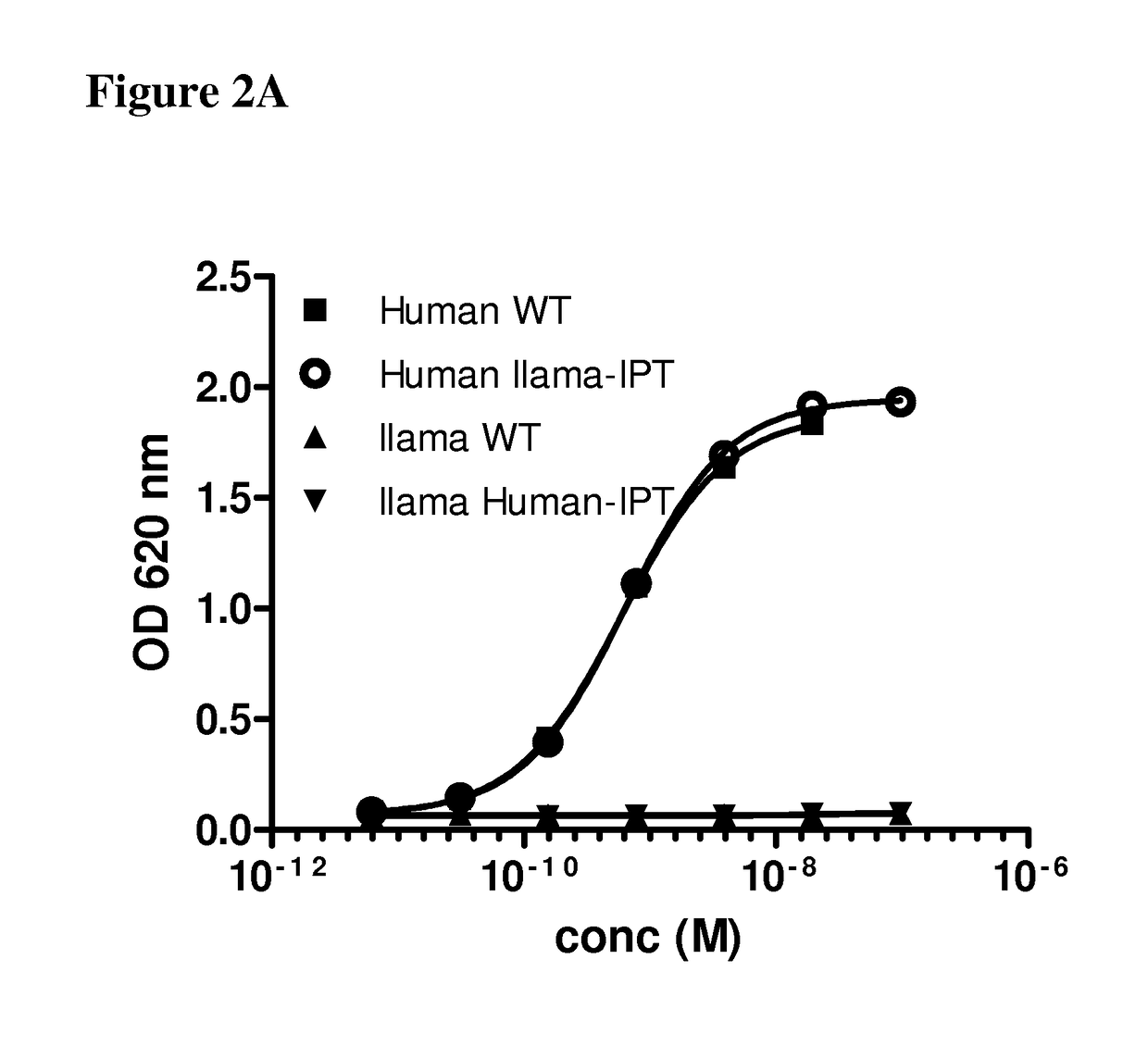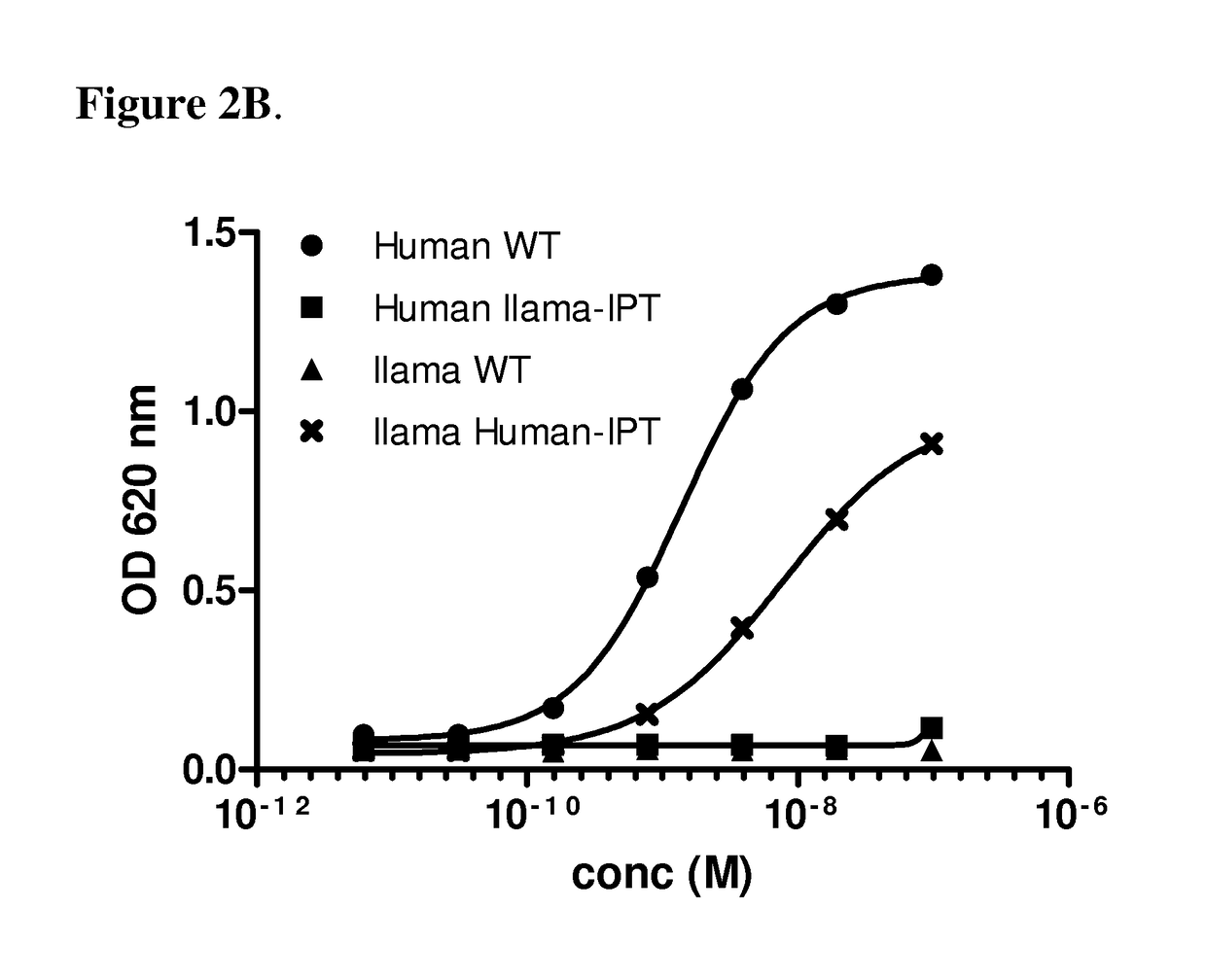Chimeric human-llama antigens and methods of use
a technology of camelids and antigens, applied in the field of chimeric, camelid/noncamelid polypeptides, can solve the problems of native, 3-, unfavorable generating or identifying antibodies that bind to epitopes
- Summary
- Abstract
- Description
- Claims
- Application Information
AI Technical Summary
Benefits of technology
Problems solved by technology
Method used
Image
Examples
example 1
Human-llama Chimeric c-Met Fusion Proteins
[0080]Human-llama chimeric c-Met extracellular domain (ECD) fusion proteins were constructed by exchanging the IPT domain of human and llama c-Met in order to map the domain recognition of the mAbs. The construction was done using standard recombinant DNA and PCR methodologies. The llama and human c-Met were amplified from RNA converted to cDNA from peripheral blood lymphocytes (PBLs) from two donors of each species. The llama and human c-Met ECD (aa 25-932) were cloned into an eukaryote expression vector with a His tag for expression as soluble proteins by HEK293 cells. The IPT1-4 (aa 568-932) from llama was exchanged with the human IPT1-4 in the human c-Met and conversely the human IPT1-4 was exchanged with the llama IPT1-4 in the llama c-Met standard recombinant DNA and notably PCR methodologies. All four constructs, llama c-Met, llama / human-IPT, human c-Met, human / llama-IPT were expressed in HEK293 cells and purified using IMAC columns. ...
example 2
Domain Mapping of mAbs Using Chimeric c-Met ECD
[0081]The binding sites of anti-c-Met antibodies 36C4, 13E6 and 48A2 were mapped using the chimeric c-Met proteins disclosed in Example 1. The 36C4 and 48A2 antibodies are fully disclosed elsewhere (see e.g., US 2012 / 0148607A1, which is hereby incorporated by reference in its entirety). Specifically, 200 ng of the different chimeric recombinant cMet proteins were immobilized on maxisorb plates overnight at 4° C. After washing with PBS, the plates were blocked with 1% casein for 2 h at RT, before the mAbs were added and allowed to bind to the c-Met for 1 h at RT. After washing, HRP-conjugated goat anti-human antibody (diluted 1 / 5000, Jackson Labs) was added and incubated for 1 h at RT before additional washing and addition of TMB. The optical density at 620 nm was read and the values were represented in a graph against the concentration of mAbs.
[0082]FIG. 2A shows binding of the 36C4 to the human c-Met (WT) and the human / llama IPT1-4 thu...
example 3
Determination of c-Met Peptide Binding Sites of mAbs 36C4 and 48A2 Using Human-llama Chimeric c-Met
[0083]To further define the amino acid (aa) stretches of c-Met to which the mAbs 36C4 and 48A2 bind, chimeric c-Met constructs containing approximately 20-300 aa exchanges from human to llama c-Met were prepared using PCR amplifications and ligations into the human c-Met containing vector with a Flag and a strep tag. FIG. 3A shows the chimeric c-Met constructs used for peptide mapping of 36C4 binding to the SEMA domain, whereas FIG. 3B shows the chimeric c-Met constructs for the peptide mapping of 48A2 binding to the PSI-IPT1 domain. The amino acid sequence of human and llama c-Met and the c-Met chimeras used in this study are set forth in Table 1, herein.
[0084]
TABLE 1Sequences of Llama-Human chimeric cMetSequenceSEQ IDnameAmino Acid SequenceNOHumanECKEALAKSEMNVNMKYQLPNFTAETPIQNVILHEHHIFLGATNYIYVLNEE1c-MetECDDLQKVAEYKTGPVLEHPDCFPCQDCSSKANLSGGVWKDNINMALVVDTYYDDQLISCGSVNRGTCQRHVFPHNHTADI...
PUM
| Property | Measurement | Unit |
|---|---|---|
| pH | aaaaa | aaaaa |
| flow rate | aaaaa | aaaaa |
| temperature | aaaaa | aaaaa |
Abstract
Description
Claims
Application Information
 Login to View More
Login to View More - R&D
- Intellectual Property
- Life Sciences
- Materials
- Tech Scout
- Unparalleled Data Quality
- Higher Quality Content
- 60% Fewer Hallucinations
Browse by: Latest US Patents, China's latest patents, Technical Efficacy Thesaurus, Application Domain, Technology Topic, Popular Technical Reports.
© 2025 PatSnap. All rights reserved.Legal|Privacy policy|Modern Slavery Act Transparency Statement|Sitemap|About US| Contact US: help@patsnap.com



